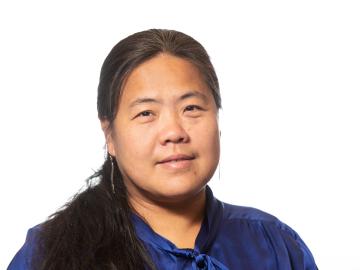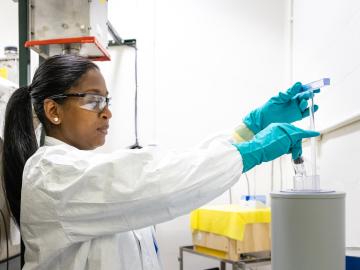
Filter News
Area of Research
- (-) Biology and Environment (31)
- (-) Materials (33)
- Advanced Manufacturing (2)
- Computational Biology (1)
- Energy Science (32)
- Fusion and Fission (7)
- Fusion Energy (1)
- Isotopes (17)
- Materials for Computing (2)
- National Security (13)
- Neutron Science (12)
- Nuclear Science and Technology (2)
- Quantum information Science (1)
- Supercomputing (42)
News Type
News Topics
- (-) Artificial Intelligence (8)
- (-) Clean Water (10)
- (-) Composites (3)
- (-) Cybersecurity (1)
- (-) Exascale Computing (5)
- (-) Isotopes (6)
- (-) Materials (21)
- (-) Space Exploration (1)
- 3-D Printing/Advanced Manufacturing (5)
- Advanced Reactors (1)
- Big Data (9)
- Bioenergy (29)
- Biology (43)
- Biomedical (10)
- Biotechnology (7)
- Buildings (1)
- Chemical Sciences (12)
- Computer Science (18)
- Coronavirus (5)
- Energy Storage (9)
- Environment (66)
- Frontier (3)
- Fusion (3)
- Grid (2)
- High-Performance Computing (13)
- Hydropower (5)
- Machine Learning (7)
- Materials Science (24)
- Mathematics (4)
- Mercury (6)
- Microscopy (15)
- Nanotechnology (12)
- National Security (2)
- Neutron Science (10)
- Nuclear Energy (10)
- Partnerships (4)
- Physics (13)
- Polymers (6)
- Quantum Computing (1)
- Security (2)
- Simulation (10)
- Summit (7)
- Transportation (4)
Media Contacts

Xiao-Ying Yu, a distinguished scientist at the Department of Energy’s Oak Ridge National Laboratory, has been named a Fellow of AVS: Science and Technology of Materials, Interfaces, and Processing, formerly American Vacuum Society.

Wildfires have shaped the environment for millennia, but they are increasing in frequency, range and intensity in response to a hotter climate. The phenomenon is being incorporated into high-resolution simulations of the Earth’s climate by scientists at the Department of Energy’s Oak Ridge National Laboratory, with a mission to better understand and predict environmental change.

Growing up exploring the parklands of India where Rudyard Kipling drew inspiration for The Jungle Book left Saubhagya Rathore with a deep respect and curiosity about the natural world. He later turned that interest into a career in environmental science and engineering, and today he is working at ORNL to improve our understanding of watersheds for better climate prediction and resilience.

With the world’s first exascale supercomputer now fully open for scientific business, researchers can thank the early users who helped get the machine up to speed.

Researchers at the Department of Energy’s Oak Ridge National Laboratory were the first to use neutron reflectometry to peer inside a working solid-state battery and monitor its electrochemistry.

Oak Ridge National Laboratory researchers recently demonstrated use of a laser-based analytical method to accelerate understanding of critical plant and soil properties that affect bioenergy plant growth and soil carbon storage.

Creating energy the way the sun and stars do — through nuclear fusion — is one of the grand challenges facing science and technology. What’s easy for the sun and its billions of relatives turns out to be particularly difficult on Earth.

Nature-based solutions are an effective tool to combat climate change triggered by rising carbon emissions, whether it’s by clearing the skies with bio-based aviation fuels or boosting natural carbon sinks.

Andrew Ullman, Distinguished Staff Fellow at Oak Ridge National Laboratory, is using chemistry to devise a better battery

A series of new classes at Pellissippi State Community College will offer students a new career path — and a national laboratory a pipeline of workers who have the skills needed for its own rapidly growing programs.


